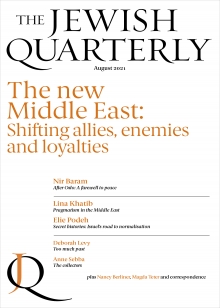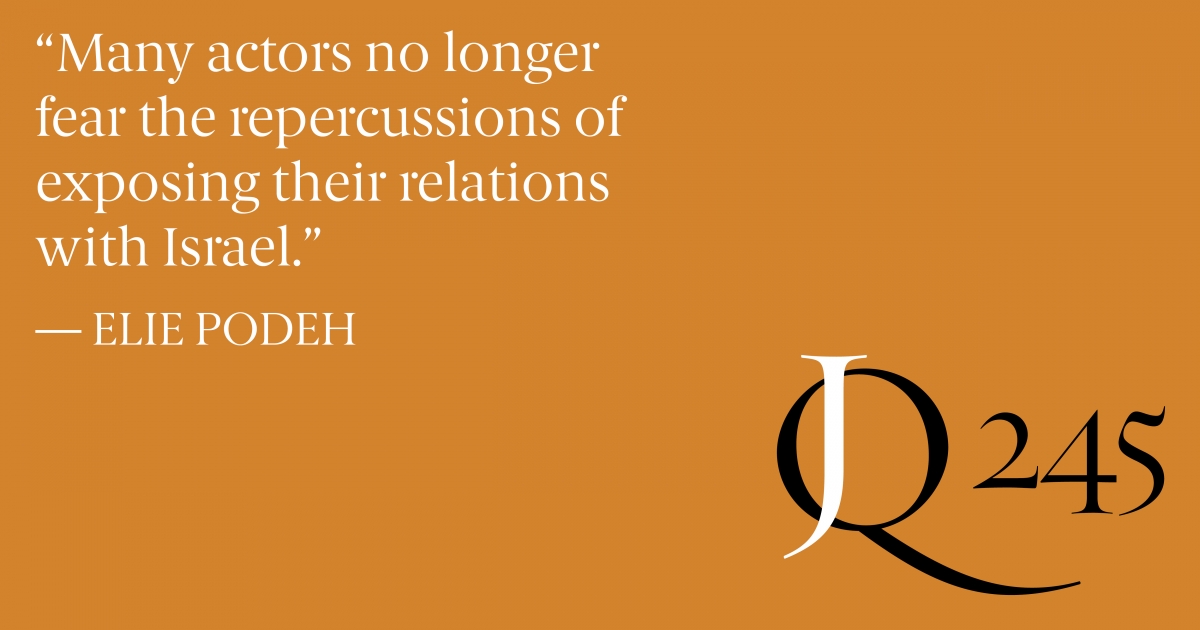
This extract is featured in The Jewish Quarterly 245: The New Middle East.
To read the full issue, log in, subscribe or buy the issue.
Secret histories
Israel’s road to normalisation
Elie Podeh
In March 2018, then Israeli prime minister Benjamin Netanyahu delivered a speech in Washington DC at the annual conference of pro-Israel lobby group AIPAC (the American Israel Public Affairs Committee). While in the city he went out for dinner with his wife, Sara, at Café Milano, a Georgetown restaurant well-known as a dining spot for top administration officials. Coincidentally, the ambassador of the United Arab Emirates, Yousef al-Otaiba, was also dining there that night, with the Bahraini ambassador and a few senior Trump administration officials. Having served in Washington since 2008, Otaiba had developed close relations with many officials, including the Israeli ambassador Ron Dermer (2013–21). According to the then New York Times White House correspondent Mark Landler, one of Otaiba’s dinner guests made contact with Netanyahu, who probably thought it was an opportunity that should not be missed. He and Sara went over to Otaiba’s table. A short chat ensued, during which Netanyahu emphasised that Israel and the UAE had reasons to strengthen their relations against their mutual Iranian enemy.
In June 2020, when the idea of annexing part of the West Bank was floating in Israeli political circles following Trump’s “deal of the century”, Otaiba published an article in the popular Israeli daily Yedioth Ahronoth. Titled “Annexation or Normalisation”, the article noted that many Arabs “would like to believe Israel is an opportunity, not an enemy. We face too many common dangers and see the great potential of warmer ties.” Seeing this as a hint, the Trump administration seized the moment. Last August, the US president made a dramatic announcement about the establishment of diplomatic relations between Israel and the UAE. Less than a month later, Bahrain followed suit. To consolidate and publicise the achievements, Trump convened a quadripartite summit in Washington in September, where the United States, the UAE, Bahrain and Israel celebrated the signing of the Abraham Accords – a symbolic title which added a religious dimension to the agreements.
Normalisation continued with the announcement of a similar deal between Israel and Sudan. Morocco established relations with Israel on 10 December.
These agreements meant Israel had relations, public or secret, with thirteen out of twenty-two members of the Arab League. The four new partnerships prompted Trump, days before he left office, to transfer Israel from the responsibility of the US European Command to the US Central Command (CENTCOM), which oversees the territory of the Middle East. This administrative decision was the culmination of a long process of Israel becoming a recognised – and desired – partner in the Middle East by major Arab players and the West in the war against mutual enemies, such as Iran.
The process of Israel’s integration into the Middle East has not yet been completed; some Arab and Muslim countries are still unwilling to recognise Israel or to deal openly with it. Many Arab people continue to object to Israel’s existence, opposing peace while the Palestinian conflict remains unresolved. And resolution looked even more difficult to achieve after the East Jerusalem confrontations in May and the eruption of serious hostilities between Israel and Hamas in the Gaza Strip. However, the normalisation era does mark a significant change in Israel’s position in the Middle East.
Until recently, the conventional assumption was that Arab states would not normalise relations with Israel before a resolution of the Palestinian problem. So what has changed? First, the Trump administration was willing to pay generously for Arab normalisation with Israel, and various states were keen to take advantage of this narrow window of opportunity. The UAE received an unprecedented arms deal, including the world’s most advanced fighter jets; Sudan was removed from the list of terror-supporting states, which is worth a fortune in Western loans and investments; and Morocco’s annexation of the internationally disputed Western Sahara was recognised by the United States. In addition, Arab states were concerned that the new Biden administration would renew the 2015 nuclear agreement with Iran, which Trump had abandoned. A public alliance with Israel was apparently meant to create a new formula of deterrence for Iran, should the United States return to the deal. A further factor is the declining importance of the Palestinian issue in the wake of the repercussions of the Arab Spring and the Covid-19 pandemic, which focused the attention of Arab states on domestic priorities. This declining importance led to the final factor: the relative indifference on the part of Arab and Muslim states to the UAE initiative to normalise relations with Israel, which in turn bolstered other rulers’ confidence, triggering a domino effect.
Still, tensions in East Jerusalem (over evictions from Sheikh Jarrah and clashes during Ramadan on the Haram al-Sharif/ Temple Mount), followed by the Israel–Hamas confrontation in May – the bloodiest clash since the Gaza war of 2014 – had a clearly negative impact.
The establishment of diplomatic relations between Israel and the UAE, Bahrain, Sudan and Morocco are the product of long-term processes, coupled with the coincidence of mutual interests and an American president eager to leave his mark. These developments led to some significant results. First, Israel’s position in the Middle East has been transformed; it currently maintains diplomatic or secret relations with at least thirteen Arab states, in addition to Turkey and several minorities. Second, many actors no longer fear the repercussions of exposing their relations with Israel, which is recognised as a useful partner against common enemies. Three, the recent agreements offer a new kind of relations: while the treaties with Egypt and Jordan produced a “cold peace” held between governmental agencies and based predominantly on mutual national security interests, the peace with the new Arab partners offers a warmer version, based on civilian, economic and cultural cooperation. Normalisation, which has a negative connotation in Arabic (tatbi’), has now gained a more positive flavour, which might affect other peace agreements in the long run.
Trump’s moves to achieve Israeli–Arab deals were enthusiastically received by Netanyahu and the Israeli right, which attempted to market them under the slogan “peace for peace”. This new “concept” was meant to convey to the Israeli public that the old formula of “land for peace” is no longer relevant or necessary. Though the idea of annexing territories in the West Bank has been dropped – at least for now – as a result of domestic Israeli politics and Emirati insistence, right-wing Israelis interpreted these four normalisation deals as a green light to continue the settlement project, thus establishing yet more facts on the ground and making a two-state solution increasingly untenable.
Yet “peace for peace” is a misleading formula. Israel has no borders with the UAE, Bahrain, Sudan or Morocco, and has never waged war against these states. As much as Israel desires peace with Arab countries on the periphery, many people in Egypt, Jordan and elsewhere in the Arab world still oppose normalisation before the resolution of the Palestinian issue. According to some Arab polls, Israel is considered the major enemy, above Iran. Some Arab states (Saudi Arabia, Oman, Qatar, Kuwait) and Muslim states (Pakistan, Indonesia) have expressed opposition to normal relations with Israel prior to a solution – or at least major progress – on the Palestinian front. The Arab states that forged relations with Israel now have leverage over it, as any unreasonable actions (annexation, for example) would probably be met by Arab retaliation, such as recalling ambassadors, severing relations and more.
Thus, although Israel has transformed its position in the Middle East, the Palestinian issue remains a vital component of the conflict and cannot simply be bypassed. For Israel, the strong imperative to make peace with the Palestinians remains, especially given the demographic forecast that Palestinians from the Jordan River to the Mediterranean, currently almost equal in number to the Jews, will soon outnumber them, threatening the very notion of a “Jewish democratic state”.
To solve the Israeli–Palestinian conflict, the two sides need to want an agreement and be willing to work for it. This was the lesson from the peace deal between Israel and Egypt, which began with secret contacts in Morocco in 1977 and led to Sadat’s visit to Jerusalem; from the deal between Israel and Jordan’s King Hussein in 1994; and from the Oslo agreements with the PLO. On the other hand, no fewer than eight American peace plans have been presented and failed: the Reagan Plan (1982), the Shultz Initiative (1988), the Clinton Parameters (2000), the Bush Road Map (2003), the Kerry Parameters (2016), and the Trump Peace Plan (2020). When both sides of the conflict had legitimate leaders who expressed willingness to take risks, and a measure of trust existed between them – only then could a skilled and committed third-party mediator bring peace. Unfortunately, the political situation on both sides of the Israel–Palestine conflict at present does not augur well for its resolution.
Though Israel’s place in the Middle East has dramatically improved since its establishment, the recent war in Gaza and the riots inside Israel confirmed that further progress is likely to be difficult and unsteady until the long-running Palestinian problem is finally addressed.
This is a 1,500 word extract of a 3,524 word essay by Elie Podeh. Get your copy of JQ245: The New Middle East to read the complete piece, along with contributions from Nir Baram, Lina Khatib, Deborah Levy and Anne Sebba.






